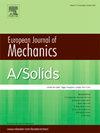Void nucleation in heterogeneous materials induced by particle-matrix debonding in polycrystalline matrix
IF 4.2
2区 工程技术
Q1 MECHANICS
引用次数: 0
Abstract
Void nucleation represents the initial stage of void evolution and plays a pivotal role in subsequent damage progression in ductile materials. This study focuses specifically on void nucleation resulting from the debonding of spherical particles from a heterogeneous polycrystalline matrix. In contrast to most previous models that assume a homogeneous matrix surrounding the particle, this study introduces a more realistic representation by modeling the matrix as an assembly of grains with randomly assigned morphologies and crystallographic orientations. The crystal plasticity (CP) model and the cohesive zone model (CZM) are employed to simulate the plastic deformation of grains and the debonding behavior at the particle–matrix interfaces, respectively. Representative volume elements (RVEs), each containing multiple grains and a single spherical particle, are used in the simulations. Three particle volume fractions and two particle positions (intragranular and intergranular) are considered. For each combination, 200 RVEs with randomized grain morphologies and orientations are generated to investigate the influence of microstructural variability on the critical stress and equivalent strain required for void nucleation under various triaxial stress states. A comprehensive dataset was generated through extensive finite element simulations, followed by statistical analysis. Based on the results, two bivariate normal distribution models were developed, each employing a specific pair of variables—critical combination stress and equivalent strain—to characterize void nucleation behavior. Compared to previous homogenized void nucleation models, the proposed models account for grain morphology and orientation effects, thereby more accurately capturing the stochastic nature of void nucleation in heterogeneous polycrystalline materials under different triaxial stress conditions and particle volume fractions. These models have also been applied in macro-level finite element (FE) simulations to characterize the stochastic behavior of void nucleation in such materials.

多晶基体中颗粒-基体脱粘诱导的非均相材料中的空洞成核
孔洞成核是孔洞演化的初始阶段,在塑性材料的后续损伤过程中起着关键作用。本研究特别关注由非均质多晶基质中球形颗粒的脱键引起的空洞成核。与之前大多数假设颗粒周围是均匀矩阵的模型相反,本研究通过将矩阵建模为具有随机分配的形态和晶体取向的颗粒组合,引入了更真实的表示。采用晶体塑性模型(CP)和内聚区模型(CZM)分别模拟了颗粒的塑性变形和颗粒-基体界面的脱粘行为。模拟中使用了包含多个颗粒和单个球形颗粒的代表性体积元(RVEs)。考虑了三个粒子体积分数和两个粒子位置(粒内和粒间)。对于每种组合,生成200个随机晶粒形貌和取向的RVEs,以研究不同三轴应力状态下微观组织变化对空洞成核所需临界应力和等效应变的影响。通过广泛的有限元模拟生成了一个全面的数据集,然后进行了统计分析。在此基础上,建立了两个二元正态分布模型,每个模型都使用一对特定变量-临界组合应力和等效应变-来表征空洞成核行为。与以往的均匀化孔洞成核模型相比,本文提出的模型考虑了晶粒形貌和取向效应,从而更准确地捕捉了不同三轴应力条件和颗粒体积分数下非均质多晶材料中孔洞成核的随机性。这些模型也被应用于宏观有限元(FE)模拟中,以表征此类材料中空洞成核的随机行为。
本文章由计算机程序翻译,如有差异,请以英文原文为准。
求助全文
约1分钟内获得全文
求助全文
来源期刊
CiteScore
7.00
自引率
7.30%
发文量
275
审稿时长
48 days
期刊介绍:
The European Journal of Mechanics endash; A/Solids continues to publish articles in English in all areas of Solid Mechanics from the physical and mathematical basis to materials engineering, technological applications and methods of modern computational mechanics, both pure and applied research.

 求助内容:
求助内容: 应助结果提醒方式:
应助结果提醒方式:


